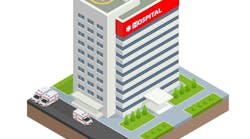The COVID-19 health emergency has dramatically elevated awareness of how easy it is to transmit viruses by touching surfaces. Hospitals and other healthcare facilities have dramatically enhanced their existing infection control procedures – examining every “touch point” within their operations to determine how to reduce touching and prevent the spread of disease. As this process continues even now, there is value for integrators in educating healthcare customers on how and where touchless methods of use can be increased – especially for routine activities – while protecting patient confidentiality and securing valuable equipment.
Electronic access systems (EAS) can be a tool to help in this effort. Since most hospitals and healthcare facilities already have secure access infrastructure in place for facility access, such as RFID cards, they can work with their integrators and electronic access solutions providers to cost-effectively extend EAS to the critical equipment within the hospital.
Along with the benefits of increased security and real-time audit trails, EAS within the hospital can enhance touchless access across a wide range of mobile and static medical equipment, providing one more tool to help minimize touch points where infections can spread.
Medical Carts: Mobile nursing stations, X-ray machines, sonograms, ventilators, cardiac and respiratory monitors, and other diagnostic machines are now both mobile and wirelessly networked into the hospital’s IT platforms. In addition, mobile carts are now regularly used to dispense medications; the drawers holding the medication must be secured while the carts are also wirelessly networked, allowing drug dispensing to be tracked and updated in real time.
One of the advantages Electronic Access Control offers is to provide a “touchless” method of entry to medical carts, making access secure and easy while minimizing the number of touched surfaces.
When combined with smartphone apps or RFID devices, concealed electronic locks and latches provide an effective solution for upgrading the security of existing carts, cabinets and workstations. In addition, a common challenge faced by many facilities is that valuable mobile equipment – like ventilators – is moved all over a facility, especially during periods of intense activity. In response, electronic access systems can provide ways for hospitals to keep track of these mobile assets.
When an electronic access system uses wireless RFID or Bluetooth-credential delivery along with concealed electro-mechanical latching systems, medical personnel never have to touch the hardware to access or relock it after their activity is complete. Wireless credentials can be sent to a concealed lock which then automatically “pops open” a compartment, thus eliminating another touch point.
Storage Areas: Touchless entry can also be extended throughout the medical establishment’s storage rooms, which often house valuable medical products and personal protective equipment. These rooms and areas can be fully secured with electronic locks that operate in the same way as mobile medical carts. Computers, cabinets and storage areas at nurses’ stations can also be secured in this way.
Patient Valuables: Many patient rooms have wheeled bedside storage units, as well as typically unsecured closets; however, many patients routinely bring valuable electronics like computers and smartphones for access to during their stay at hospitals or rehabilitation facilities.
Incorporating electronic locks with Bluetooth readers can help address this need. When a patient is admitted to a hospital, either they or a family member could be supplied with a smartphone app that provides a unique electronic key to control access to a secure storage unit.
The electronic lock could incorporate a Bluetooth reader so the patient could use their smartphone to access and secure their valuables. When the patient checks out, the credential can be easily deactivated. This can greatly help hospital administrators who routinely face concerns from patients about lost or stolen valuables during their stay.
Steve Spatig is General Manager of Electronic Access Solutions for Southco Inc. Request more info about the company at www.securityinfowatch.com/10715738.


